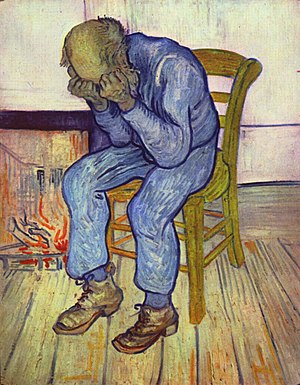
Image via Wikipedia
On August 15, I published an op-ed piece in The New York Times expressing the view that normal grief is normal and should not be confused with Major Depressive Disorder (MDD). The DSM-5 suggestion to remove the bereavement exclusion for MDD would convert grief after losing a loved one into mental disorder. Two short weeks of expetable symptoms like sadness, insomnia, difficulty working, and loss of interest, appetite, and energy would qualify for an MDD diagnosis. This mislabeling would then often trigger stigma and unnecessary medication treatment. More details can be found in the op-ed piece itself or on previous numbers of this blog.
On August 20, the Times published a number of letters taking all sides on the issue. There were two rejoinders to my view that I believe are misleading enough to require comment:
Counter Argument 1: Patients experiencing a well-established Major Depressive Episode (MDE) beginning during bereavement are no different in presentation and treatment response than those whose MDE follows after other severely stressful life events.
Reply: True enough, but totally irrelevant to my concern. Well established MDD is not in question (it is already diagnosable in DSM- IV-TR). The respondents continue to confuse the issue by focusing only on the already well established cases of MDD with a duration in studies usually greater than two months These are the true positives and there is no controversy whatever regarding their diagnosis. Well established (i.e. severe or enduring) MDD during bereavement has never been the issue.
It is the false positives I worry about -- those with normal and time-limited grief that will remit in the natural course of things without diagnosis or treatment. Two weeks is far too short a duration when we are considering relatively mild symptoms that are so intrinsic to grieving. Rushing to judgment that a mental disorder is present will lead to remarkably high false positive rates and transform normal grief into a medical disorder.
Counter Argument 2: The respondents claim that the DSM-5 intention is only to diagnose MDD, not to include normal grief.
Reply: The crucial and clinching point is that these are clinically completely indistinguishable at frequently encountered levels of normal grief. Prospective studies show that almost half of all the bereaved reach MDE two-week symptom thresholds sometime during the first year after their loss, usually within the first two months. I challenge anyone to distinguish clinically between two weeks of normal grief and two weeks of mild MDD under these circumstances. I certainly can't make this distinction, I very much doubt that my respondents can, and I feel sure that primary care physicians can't manage it while seeing a grieving patient in a seven minute evaluation.
Distinguishing grief from MDD is no problem when symptoms become severe or are enduring. DSM-IV-TR already recognizes this. It allows the diagnosis of MDD anytime during bereavement when there is suicidality, psychosis, morbid worthlessness, psychomotor retardation, or inability to function. This is meant to encourage early diagnosis and active psychiatric intervention whenever this is needed. There is no compelling problem that needs fixing. Grieving patients who need psychiatric help already get it.
Before jumping the gun to a premature and potentially harmful diagnosis, why not watchfully wait a few more weeks to determine if the grief is severe and enduring enough to warrant the label of mental disorder. To do as DSM-5 suggests would instead mislabel a substantial portion of normal grievers and would inappropriately stretch the boundary of psychiatry by medicalizing grief.



Leave a comment